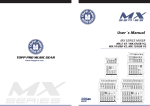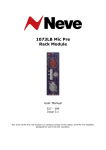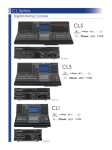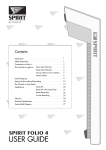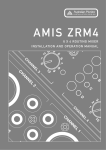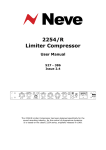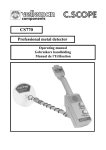Download Aphex Systems Dominator II 722 User's Manual
Transcript
Dominator ™ II Precision MultiBand Peak Limiter Models 720, 722 Model 720 The Dominator II from Aphex Systems is a stereo multiband peak limiter designed to fit a wide range of applications. Through the use of multiband techniques along with new proprietary circuits, the audibility of limiting action has been greatly reduced, especially when compared to conventional limiters. This means that greater limiting depth is possible, resulting in higher loudness with maintained audio quality. At virtually any limiting depth, the Dominator II is free of “hole punching”, “dullness”, and most other effects normally associated with limiters. As a peak overshoot protection limiter, the Dominator II is undetectable in line while it absolutely prevents peak levels from exceeding a user settable output level. In addition, the desired limiting effects of greater audio density and increased “punch” are readily available with the Dominator II. FEATURES • • • • • • • • • • • Peak Ceiling Trimmable in 0.2dB Steps Over a 34dB Range 3 Bands of Limiting with Switchable Crossover Frequencies Patented Automatic Limit Threshold (ALT) Circuitry Freedom from Pumping Freedom from Spectral Gain Intermodulation Adjustable Density (Relative Crest Height) Calibrated Detented Potentiometers 104dB Dynamic Range LF and HF EQ Provides Shaping Equalization Below Peak Ceiling Relay Bypass, Remote Controllable Servo-Balanced Transformerless Inputs and Outputs Aphex Dominator II Precision MultiBand Peak Limiter Models 720, 722 Why is the Dominator So Special? A very significant problem with wideband processing is “spectral gain intermodulation” which occurs when one part of the spectrum controls the level of another part. A typical situation is a vocalist being “sucked down” every time the kick drum hits. Since most energy is contained in the lower frequencies, they tend to control the level of the entire spectrum. When the lower frequencies are above the limit threshold the higher frequencies are attenuated thus causing the output to sound dull. Multiband processing solves these problems by splitting the audio into two or more frequency bands and processing each band separately. However, more bands often result in many more parameters to control including a method of summing the bands together again. While giving the user flexibility, it also requires different settings for almost every different source. The Dominator ll uses program dependent, intelligent circuits to reduce the number of controls. The user, therefore, has flexibility to shape the sound while quickly and easily achieving the goal of consistent, effective limiting. The Secret Ingredient: ALT A multiband processor splits the audio into separate bands, limits each band individually and then sums the bands together again. Even though each band’s peak output is predictable, summing the bands together produces an unpredictable peak output. One conventional approach to making the summed output predictable is to use a wideband limiter after the summing. This, however, introduces all the drawbacks of wideband limiting discussed above. Another approach is to use a clipper on the summed output. This causes too much clipping distortion if the summed output is too high. In order to avoid this distortion the limiters’ thresholds are set very far below the clipper threshold. The drawback is a loss of loudness and, due to the lower thresholds, much greater amount of processing. The Dominator ll uses a patented method to produce a predictable peak output while maintaining maximum loudness without audible distortion- the Automatic Limit Threshold (ALT). The outputs of the three bands are summed and sent to the ALT detector circuit. If the sum exceeds a reference value, the ALT reduces the thresholds of the individual limiters. When the summed output falls below the reference value the limit thresholds return to their original setting. The ALT circuit has a self-adjusting finite attack time. The amount of time it takes to lower the thresholds of the limiters is the length of time the limiters’ overshoot may be in the clipper. The reference value of the ALT in relation to the clipper determines the depth of clipping. Both parameters are set by the Density control. When the Density control is set higher, the ALT reference gets closer to clipping, and the attack time is slower, producing more clipping. The opposite occurs when Density is set lower. The “0 RCH” position for the Density control emulates the standard parameters of the original Studio Dominator Model 700, and is recommended for general use. PROCESS OFF/ON switches the audio through the unit or through bypass relays. LF EQ - adjust input level to the low frequency band ±5dB. Center detent is flat response below limiting. RELEASE - adjusts release time of the limiters between 150mSec (fully clockwise) and 7Sec (fully counter-clockwise). STEREO forces th band to limiting the othe band in has a gr limiting. INPUT GAIN - adjusts input level ±15dB. Center detent is unity gain. XOVER 1 - switches the crossover point between low and mid bands from 100Hz to HF EQ - adjusts input level to the high frequency band ±5dB. Center detent is flat XOVER crossov mid and 1.7kHz Model 720 It should be noted that there is only one ALT circuit controlling both channels equally. This provides global stereo balance and imaging by assuring that both channels always limit at the same threshold. This does cause an interaction if the Dominator ll is used as two independent channels. Therefore, we do not recommend such a practice. Model 722 Broadcast Dominator Pre-emphasis is an equalization curve expressed as a time value based on the ratio of a resistor and capacitor. The higher the value, the greater the equalization. It has been employed as a noise reduction technique for broadcast and transmission links. There are primarily two world standards- 50 and 75 microseconds. Model 722 The Dominator ll Model 722, has separately switchable pre and de-emphasis curves. When pre-emphasis is switched in, either 50 or 75 microseconds, the equalization curve is added after the input stage and before the limiters. When de-emphasis is switched in, the complementary de-emphasis curve is inserted after the final clipper and before the output stage. When both pre and de-emphasis are switched in and when input is below threshold, the frequency response of the output is flat. As the input increases above threshold, the output takes the shape of the de-emphasis curve. When both pre and de-emphasis are switched out, the Model 722 works exactly like the Model 720. ach and of nnel of he en om Applications Sound Contracting — protection of amplifiers and speakers from overload; increased loudness; maximized use of available power. Recording — preventing sudden peak overload of mixer or recorder; tightening tracks; special effects, etc. Mixing — used as a program limiter, the Dominator ll will keep a track “rock steady” for “layering” into or on top of a mix. Digital Sampling — obtaining good full scale samples free from peak overload, i.e. no more missed samples. Digital Recording — insuring clean recording by stopping clipping of peaks and overshoots. Maximizes bit usage for less distortion. Satellite Uplink — Modulation control to prevent splattering on high frequency audio, gives reduced distortion, better signal-to-noise. Broadcasting — AM and FM modulation control for increased loudness; cleaner sound; use in production for greater consistency of tapes, punchier voice-overs. Location Film Shoots — anti-crash for dialog and sound effects recording. Post Production — Soundtrack peak control; managing difficult dialog; controlling transient sound effects. Optical Recording and Transfer — prevents “valve clash”, gives higher average level with low distortion and better signal-to-noise performance. Analog Disk Mastering — peak control for high allowable average cutting levels; less limiter degradation to the program; brighter, punchier sound. C/D Mastering — peak and density control for more accurate digitizing, cleaner sound requiring less error correction on playback; no limiter induced sound degradation. STL & Phone Line Driver — maximize signal-tonoise without overload distortion. Video and Audio Tape Duplication — “Hotter” transfers without saturation. RCH DENSITY - adjusts the Relative Crest Height (RCH) of the output. The higher the RCH (clockwise) the louder the output. The lower the RCH (counter-clockwise) the lower the average level in the output. RANGE - when switched to the “.10” position it adds a 10dB boost in the input and a 10dB cut in the output. The PEAK CEILING is therefore 10dB lower than the settings shown on COARSE and FINE controls. LIMITING (meter) displays the limiting (from gain reduction and clipping) in the channel with the greatest amount of limiting. FINE - adjusts the PEAK CEILING by ±1dB in 0.2dB steps. COARSE - switches the PEAK CEILING in 2dB steps from +2 to +24dB(pk). POWER - switches AC mains on and off. “Off” position engages bypass relays. Dominator ™ II NOMINAL OPERATING LEVEL (Peak Ceiling RANGE switch) INPUT Connector: Type: Models 720, 722 0dBu (for use with +4 or +8dBu) -10dBu Nominal Level: Maximum Level: CMRR (typical): RF Rejection: 3-Pin XLR female (pin 1 ground, pin 2 positive, pin 3 negative) Transformerless, servo balanced with passive 4th order RF filter Chassis grounded per AES standards 19.5 kΩ Unterminated; same 600Ω with rear-panel terminator engaged same (terminator lifts in bypass) from 0dBu to +8dBu from -10dBu to 0dBu +26dBu +16dBu (+14.8dBV) > 50dB 20Hz to 10kHz same > 28dB at 800 kHz; > 60dB above 2 mHz same OUTPUT Connector: Type: Output Impedance: Nominal Level: Maximum Level: 3-Pin XLR male (pin 1 ground, pin 2 positive, pin 3 negative) Transformerless, servo balanced, chassis grounded per AES standards 65Ω same from 0dBu to +8dBu from -10dBu to 0dBu +25dBu PK* +15dBu PK* Impedance: AUDIO (Controls set for unity gain, no limiting and flat response except as otherwise noted) Frequency Response: +0.2dB 4.5Hz - 50kHz same Dynamic Range: > 108dB > 106dB Hum & Noise (unweighted, 22 Hz - 22 kHz): < -82dBu < -90dBu Crosstalk: < -60dB up to 10kHz same THD (Ref.: 1kHz, no limiting): < 0.006% (+12dBu in) < 0.006% (+2dBu in) SMPTE IMD: < 0.006% (+12dBu in) < 0.006% (+2dBu in) 720/722 CONTROL & METERING PARAMETERS (on front panel unless otherwise noted) INPUT GAIN: +14/-21 dB typical same PROCESS ON/OFF: ON: Active / OFF: Hardwire Bypass same LF EQ Boost/Cut: ± 5 dB same HF EQ Boost/Cut: ± 5 dB same XOVER 1 Frequency: 100 Hz / 210 Hz same XOVER 2 Frequency: 1.7 kHz / 3.4 kHz same RELEASE Time: 150 mSec to 7 Sec same RCH (Relative Crest Height) DENSITY: -5 to +5 same STEREO COUPLING: ON / OFF same PEAK CEILING: +1 to +25dBu (PK)** -9 to +15dBu (PK)** Peak Ceiling is adjusted with the COARSE (2dB steps), FINE (0.2dB steps) and RANGE (0dB/-10dB) controls LIMITING Meter: 10 segment meter indicates up to 15dB of gain reduction in the channel with the greatest amount of limiting 600 OHM INPUT TERMINATION: Each channel is switchable on rear panel (lifts in bypass) REMOTE Control Jack: A four pin RJ11 telephone-style connector on the rear panel provides remote control capacity of the PROCESS ON/OFF bypass relays and dry “tally” contact for a remote status indicator 722 CONTROL PARAMETERS (722 only) EMPHASIZED LIMITING (switches are located on the rear panel with LED function indicators located on the front panel) DE-EMP (De-emphasis): ON / OFF same PRE-EMP (Pre-emphasis): ON / OFF same TIME CONSTANT (Microseconds): 75mS / 50mS same OTHER SPECIFICATIONS Power Input: IEC standard receptacle with voltage selector, fuse and filter Power Requirements: 100, 120, 220, or 240 VAC; 50 or 60 Hz Power Consumption: 30 watts maximum Power Fuse: Slow blowing type- 100/120 VAC: 0.375 A; 220/240 VAC: 0.25A Net Weight: 6 lbs. (2.72 kg) Shipping Weight: 9 lbs. (4.08 kg) Dimensions: 19” W x 1.75” H x 9.63” D (482.6 mm x 44.5 mm x 244.6 mm) EIA Mounting: Mounts in standard 19” rack, using 1 RU of vertical space and 8.8” (223mm) of depth behind front panel (not including power or I/O cables) * Maximum Output Level is limited by the PEAK CEILING setting. The output stage is capable of +26dBu into 600Ω. ** dB (PK) = peak value of sine wave. 11068 Randall Street • Sun Valley, CA 91352 • (818) 767-2929 • FAX (818) 767-2641 Aphex is proudly American…100% owned, engineered and manufactured in the U.S.A. Aphex is a registered trademark of Aphex Systems, Ltd. Aphex is constantly striving to maintain the highest professional standards. As a result of these efforts, modifications may be made from time to time to existing products without prior notice. Specifications and appearance may differ from those listed or shown.






